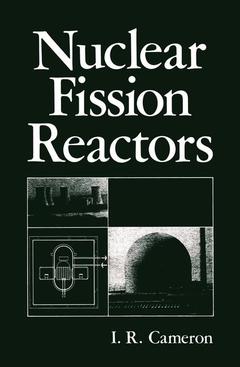Nuclear Fission Reactors, 1982
Langue : Anglais
Auteur : Cameron I. R.

This book is intended to provide an introduction to the basic principles of nuclear fission reactors for advanced undergraduate or graduate students of physics and engineering. The presentation is also suitable for physicists or engineers who are entering the nuclear power field without previous experience with nuclear reactors. No background knowledge is required beyond that typically acquired in the first two years of an undergraduate program in physics or engineering. Throughout, the emphasis is on explaining why particular reactor systems have evolved in the way they have, without going into great detail about reactor physics or methods of design analysis, which are already covered in a number of excellent specialist texts. The first two chapters serve as an introduction to the basic physics of the atom and the nucleus and to nuclear fission and the nuclear chain reaction. Chapter 3 deals with the fundamentals of nuclear reactor theory, covering neutron slowing down and the spatial dependence of the neutron flux in the reactor, based on the solution of the diffusion equations. The chapter includes a major section on reactor kinetics and control, including'tempera ture and void coefficients and xenon poisoning effects in power reactors. Chapter 4 describes various aspects offuel management and fuel cycles, while Chapter 5 considers materials problems for fuel and other constituents of the reactor. The processes of heat generation and removal are covered in Chapter 6.
1.Basic Physics of the Atom and the Nucleus.- 1.1. The Nuclear Atom.- 1.2. The Structure of the Atom.- 1.3. Radioactivity.- 1.3.1. ?, ?, and ? Emission.- 1.3.2. The Systematics of Radioactive Decay.- 1.4. Mass Defect and Binding Energy.- 1.5. Interactions of Neutrons with the Nucleus.- 1.6. Cross Sections for Neutron Reactions.- 1.7. Cross Sections of Particular Importance in Reactor Physics.- 1.8. Experimental Techniques.- 1.8.1. Neutron Sources.- 1.8.2. Detection of Charged Particles and ? Rays.- 1.8.3. Neutron Detectors.- 2. Nuclear Fission and the Nuclear Chain Reaction.- 2.1. Nature of the Fission Process.- 2.2. The Products of Fission.- 2.3. Energy Release in Fission.- 2.4. The Nuclear Chain Reaction.- 2.5. The Role of Plutonium in Nuclear Reactors.- 2.6. Nuclear Cross Sections of the Fissile Isotopes.- 3. Elements of Nuclear Reactor Theory.- 3.1. The Neutron Energy Spectrum in a Nuclear Reactor.- 3.2. The Spatial Dependence of the Neutron Flux in a Reactor.- 3.2.1. One-Group Method.- 3.2.2. Two-Group Method.- 3.3. The Heterogeneous Reactor.- 3.4. Reactor Kinetics and Control.- 3.4.1. Kinetics of the Reactor without Feedback.- 3.4.2. Reactivity Effects Arising from Power Operation.- 3.4.3. Fission Product Poisoning.- 4. Nuclear Fuels and Their Characteristics.- 4.1.Nuclear Properties of Fissile Materials.- 4.2.Buildup of Plutonium in a Natural Uranium Reactor.- 4.3.The Th232—U233 Fuel Cycle.- 4.4.Aspects of Fuel Management in Thermal Reactors.- 5. Materials Problems for Nuclear Reactors.- 5.1. Effects of Irradiation on Reactor Materials.- 5.2. Uranium—Production and Enrichment.- 5.3. Properties of Uranium Metal.- 5.4. Ceramic Uranium Fuel.- 5.5. Dispersion-Type Fuel Elements.- 5.6. Graphite.- 5.7. Stainless Steel.- 5.8. Zirconium.- 5.9. Light and Heavy Water.- 6.Heat Generation and Removal in Nuclear Reactors.- 6.1. Introduction.- 6.2. Maximum Heat Generation Rate in Fuel.- 6.3. Heat Conduction in Fuel Elements.- 6.3.1. The Poisson Equation.- 6.3.2. Solutions of the Poisson Equation.- 6.4. Temperature Distributions along a Coolant Channel.- 6.4.1. Heat Transfer by Convection.- 6.4.2. Axial Variation of Fuel, Clad, and Coolant Temperatures.- 6.5. Heat Transfer by Boiling Coolant.- 6.6. Nuclear Power Reactor Cooling Systems.- 6.6.1. Choice of Coolant.- 6.6.2. Water-Cooled Reactors.- 6.6.3. Gas-Cooled Reactors.- 6.6.4. Liquid Metal Cooling.- 6.6.5. Superheat and Reheat.- 7.General Survey of Reactor Types.- 7.1.Introduction.- 7.2.Classification of Thermal Reactors.- 8. The Gas-Cooled Graphite-Moderated Reactor.- 8.1. General Characteristics of the Gas-Cooled Graphite-Moderated Reactor.- 8.2. The Magnox Natural Uranium Graphite-Moderated Reactor.- 8.3. The Advanced Gas-Cooled Reactor.- 8.4. The High-Temperature Gas-Cooled Reactor.- 9. The Light-Water-Moderated Reactor.- 9.1. General Characteristics of the Light-Water-Moderated Reactor.- 9.2. Development of the Light Water Reactor.- 9.3. The Pressurized Water Reactor.- 9.4. The Boiling Water Reactor.- 10. The Heavy-Water-Moderated Reactor.- 10.1. General Characteristics of the Heavy Water Reactor.- 10.2. The CANDU Pressure Tube Heavy Water Reactor.- 11. The Fast Reactor.- 11.1. Introduction.- 11.2. The Physics and Technology of Fast Reactors.- 11.3. Dynamic Behavior and Safety Aspects of the Fast Reactor.- 11.4. The Dounreay Prototype Fast Reactor.- 12. Safety and Environmental Aspects of Nuclear Reactors.- 12.1.The Biological Effects of Radiation.- 12.2. Effects of Routine Release of Radioactivity from the Nuclear Industry.- 12.2.1. Dose Limits for Radiation Exposure.- 12.2.2. Release of Radioactive Isotopes from Nuclear Power Plants.- 12.2.3. Estimated Radiation Doses Due to the Nuclear Fuel Cycle.- 12.3. Reactor Accidents: Safety Studies on Light Water Reactors.- 12.3.1. Analysis of LWR Safety.- 12.3.2. Accident Experience with Light Water Reactors.- 12.4. Reactor Accidents: Thermal Reactors Other than LWRs.- 12.4.1. The Gas-Cooled Graphite-Moderated Reactor.- 12.4.2. The Heavy Water Reactor.- 12.5. The Safety of the Fast Breeder Reactor.- 12.6. Long-term Storage and Disposal of Radioactive Wastes.- 12.7. The Thermal Effects of Nuclear Power Stations.
Date de parution : 10-2011
Ouvrage de 398 p.
15.5x23.5 cm
Disponible chez l'éditeur (délai d'approvisionnement : 15 jours).
Prix indicatif 137,14 €
Ajouter au panier
© 2024 LAVOISIER S.A.S.



